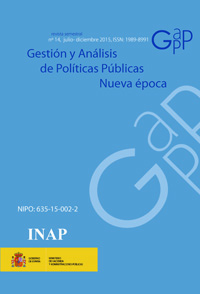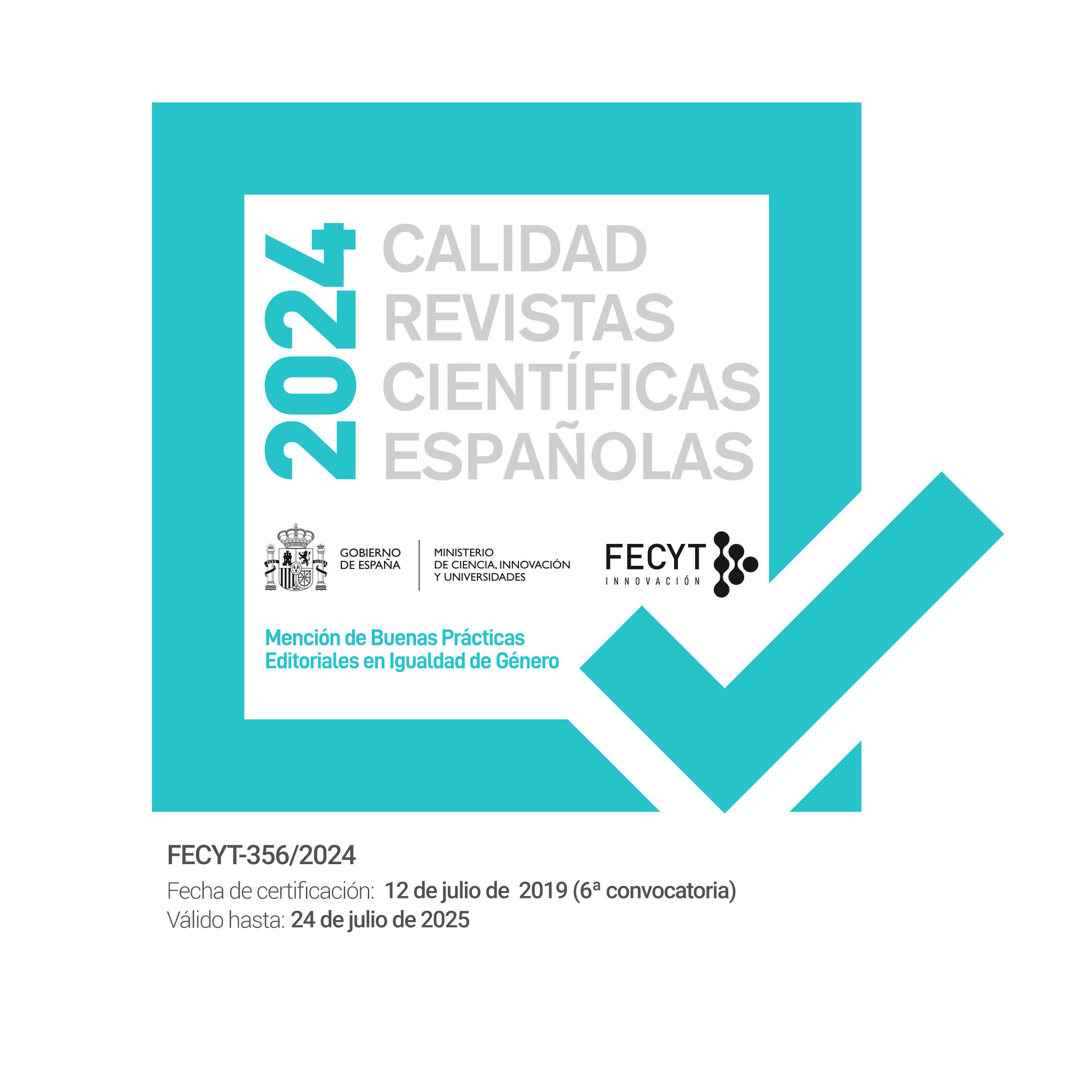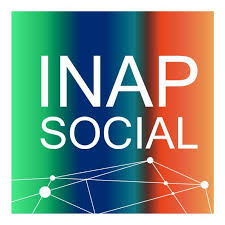Estrategias de análisis estructural aplicadas a la evaluación de Políticas Públicas
DOI:
https://doi.org/10.24965/gapp.v0i14.10289Palabras clave:
Análisis de redes sociales, coaliciones, evaluación de programas, implementación, políticas públicas, redes inter-organizativasResumen
Las políticas públicas suelen materializarse a través de programas implementados por diferentes organismos. Cuando son varias agencias las encargadas de llevar a cabo un programa, este conjunto de organizaciones puede adoptar la forma de una red inter-organizativa. El análisis estructural hace posible evaluar este tipo de estructuras en orden a que los resultados de la evaluación puedan incidir positivamente sobre la iniciativa puesta en marcha a través de la red. En este artículo presentamos el potencial del Análisis de Redes Sociales (ARS) para evaluar redes inter-organizativas que ponen en funcionamiento programas de intervención. El manuscrito se divide en cuatro secciones. La primera está dedicada a mostrar antecedentes en los que se emplea el análisis de redes inter-organizativas en la evaluación de programas. En la segunda repasamos los elementos claves para diseñar un análisis estructural, prestando especial atención a los niveles de análisis y a cuestiones relativas al muestreo y al procedimiento de extracción de datos. El tercer bloque se centra en exponer diferentes indicadores que pueden emplearse para evaluar redes inter-organizativas. En la última sección reflexionamos sobre el potencial del ARS en la evaluación de políticas públicas y revisamos técnicas emergentes que pueden mejorar los resultados de la evaluación.Descargas
Citas
Abbasi, A., y Kapucu, N. (2012), “Structural dynamics of organizations during the evolution of interorganizational networks in disaster response”, Journal of Homeland Security and Emergency Management, 9(1): 1547. DOI: 10.1515/1547-7355.1975.
Atkinson, R., y Flint, J. (2001), “Accessing hidden and hard-to-reach populations: Snowball research strategies”, Social Research Update, 33(1): 1-4.
Bastian, M., Heymann, S., y Jacomy, M. (2009), “Gephi: an open source software for exploring and manipulating networks”, ICWSM, 8: 361-362.
Berg, E. (2006), “Snowball sampling—I”, Encyclopedia of Statistical Sciences. John Willey & Sons, Inc. DOI: 10.1002/0471667196.ess2478.pub2.
Biernacki, P., y Waldorf, D. (1981), “Snowball sampling: Problems and techniques of chain referral sampling”, Sociological Methods & Research, 10(2): 141-163. DOI: 10.1177/004912418101000205.
Borgatti, S.P., y Everett, M.G. (1999), “Models of Core/Periphery structures”, Social Networks, 21: 375-395. DOI: 10.1016/S0378-8733(99)00019-2.
Borgatti, S.P., y Molina, J.L. (2003), “Ethical and strategic issues in organizational social network analysis”, The Journal of Applied Behavioral Science, 39(3): 337-349. DOI: 10.1177/0021886303258111.
Browne, K. (2005), “Snowball sampling: using social networks to research non-heterosexual women”, International Journal of Social Research Methodology, 8(1): 47-60. DOI: 10.1080/1364557032000081663.
Buchthal, O. V., Taniguchi, N., Iskandar, L., y Maddock, J. (2013), “Assessing state-level active living promotion using network analysis”, Journal of Physical Activity and Health, 10: 19-32.
Bunger, A. C., Doogan, N. J., y Cao, Y. (2014), “Building Service Delivery Networks: Partnership Evolution Among Children’s Behavioral Health Agencies in Response to New Funding”, Journal of the Society for Social Work and Research, 5(4): 513-538. DOI: 10.1086/679224.
Cardazone, G., Sy, A. U., Chik, I., y Corlew, L. K. (2014), “Mapping one strong ‘Ohana: Using network analysis and GIS to enhance the effectiveness of a statewide coalition to prevent child abuse and neglect”, American Journal of Community Psychology, 53(3-4): 346-356. DOI: 10.1007/s10464-014-9641-7.
Carley, K. M., Pfeffer, J., Reminga, J., Storrick, J., y Columbus, D. (2013), ORA User’s Guide 2013. Carnegie Mellon University, School of Computer Science, Institute for Software Research, Technical Report, CMU-ISR-13-108,
Chavis D. (2001), “The Paradoxes and Promise of Community Coalitions”, American Journal of Community Psychology, 29(2): 309-320. DOI: 10.1023/A:1010343100379.
Cross, J. E., Dickmann, E., Newman-Gonchar, R., y Fagan, J. M. (2009), “Using mixed-method design and network analysis to measure development of interagency collaboration”, American Journal of Evaluation, 30(3): 310-329. DOI: 10.1177/1098214009340044.
Dekker, D., Krackhardt, D., y Snijders, T. A. B. (2007), “Sensitivity of MRQAP tests to collinearity and autocorrelation conditions”, Psychometrika, 72: 573-581. DOI: 10.1007/s11336-007-9016-1.
De Nooy, W., Mrvar, A., y Batagelj, V. (2011), Exploratory social network analysis with Pajek (Vol. 27). Cambridge University Press.
Eisenberg, M., y Swanson, N. (1996), “Organizational network analysis as a tool for program evaluation”, Evaluation & the Health Professions, 19(4): 488-506. DOI: 10.1177/016327879601900407.
Feinberg, M., Riggs, N. R., y Greenberg, MT (2005), “Social networks and community prevention coalitions”, Journal of Primary Prevention, 26(4): 279-298. DOI: 10.1007/s10935-005-5390-4.
Freeman, L. C. (1979), “Centrality in social networks conceptual clarification”, Social Networks, 1(3): 215-239. DOI: 10.1016/0378-8733(78)90021-7.
Friedkin, N. E. (1981), “The development of structure in random networks: an analysis of the effects of increasing network density on five measures of structure”, Social Networks, 3(1): 41-52. DOI: 10.1016/0378-8733(81)90004-6.
García-Valdecasas, J. I. (2011), “La simulación basada en agentes: una nueva forma de explorar los fenómenos sociales”, Revista Española de Investigaciones Sociológicas, 136(1): 91-109. DOI: 10.5477/cis/reis.136.91.
Gulati, R. (1995), “Social structure and alliance formation patterns: a longitudinal analysis”, Administrative Science Quarterly, 40: 619-652. DOI: 10.2307/2393756.
Gulati, R., y Sytch, M. (2007), “Dependence asymmetry and joint dependence in interorganizational relationships: Effects of embeddedness on a manufacturer’s performance in procurement relationships”, Administrative Science Quarterly, 52(1): 32-69. DOI: 10.2189/asqu.52.1.32.
Haines, V. A., Godley, J., y Hawe, P. (2011), “Understanding interdisciplinary collaborations as social networks”, American Journal of Community Psychology, 47(1-2): 1-11. DOI: 10.1007/s10464-010-9374-1.
Harris, J. K., Luke, D. A., Burke, R. C., y Mueller, N. B. (2008), “Seeing the forest and the trees: using network analysis to develop an organizational blueprint of state tobacco control systems”, Social Science & Medicine, 67(11): 1669-1678. DOI: 10.1016/j.socscimed.2008.07.013.
Harris, J. K., Provan, K. G., Johnson, K. J., y Leischow, S. J. (2012), “Drawbacks and benefits associated with inter-organizational collaboration along the discovery-development-delivery continuum: a cancer research network case study”, Implementation Science, 7(1): 69-83. DOI: 10.1186/1748-5908-7-69.
Huisman, M., y van Duijn, Marijtje A. J. (2011), “A reader’s guide to SNA software”. En J. Scott and P.J. Carrington (Eds.) The SAGE Handbook of Social Network Analysis (pp. 578-600). London: SAGE.
Huxham, C., y Vangen, S, (2005), Managing to Collaborate: The Theory and Practice of Collaborative Advantage. London: Routledge.
Isett, K. R., Mergel, I. A., LeRoux, K., Mischen, P. A., y Rethemeyer, R. K. (2011), “Networks in public administration scholarship: Understanding where we are and where we need to go”, Journal of Public Administration Research and Theory, 21(suppl 1): i157-i173. DOI: 10.1093/jopart/muq061.
Isett, K. R., y Provan, K. G. (2005), “The evolution of dyadic interorganizational relationships in a network of publicly funded nonprofit agencies”, Journal of Public Administration Research and Theory, 15(1): 149-165. DOI: 10.1093/jopart/mui008.
Jones, C., Hesterly, W. S., y Borgatti, S. P. (1997), “A general theory of network governance: Exchange conditions and social mechanisms”, Academy of Management Review, 22(4): 911-945. DOI: 10.5465/AMR.1997.9711022109
Jordana, J. (2009), “Examinando las redes de actores en el análisis de las políticas públicas: debate teórico y técnicas cuantitativas”, Gestión y Análisis de Políticas Públicas, 1: 9-16.
Kickert, Walter J. M., Erik-Hans Klijn, y Koppenjan, J. (eds.) (1997), Managing Complex Networks: Strategies for the Public Sector. London: Sage Publications.
Knoke D., y Yang, S. (2008), Social Network Analysis. Sage Publications Thousand Oacks. California. C. A.
Krackhardt, D. (1988), “Predicting with networks: Nonparametric multiple regression analysis of dyadic data”, Social Networks, 10: 359–381. DOI: 10.1016/0378-8733(88)90004-4.
Lecy, J. D., Mergel, I. A., y Schmitz, H. P. (2014), “Networks in Public Administration: Current scholarship in review”, Public Management Review, 16(5): 643-665. DOI: 10.1080/14719037.2012.743577.
Li, J., Weeks, M. R., Borgatti, S. P., Clair, S., y Dickson-Gomez, J. (2012), “A social network approach to demonstrate the diffusion and change process of intervention from peer health advocates to the drug using community”, Substance Use & misuse, 47(5): 474-490. DOI: 10.3109/10826084.2012.644097.
Long, J. C., Cunningham, F. C., y Braithwaite, J. (2013), “Bridges, brokers and boundary spanners in collaborative networks: a systematic review”, BMC Health Services Research, 13(1): 158. DOI:10.1186/1472-6963-13-158.
Luke, D. A., Harris, J. K., Shelton, S., Allen, P., Carothers, B. J., y Mueller, N. B. (2010), “Systems analysis of collaboration in 5 national tobacco control networks”, American Journal of Public Health, 100(7):1290-1297. DOI: 10.2105/AJPH.2009.184358.
Macal, C. M., y North, M. J. (2010), “Tutorial on agent-based modelling and simulation”, Journal of Simulation, 4(3): 151-162. DOI:10.1057/jos.2010.3.
Mascia, D., Cicchetti, A., y Damiani, G. (2013), “Us and Them: a social network analysis of physicians’ professional networks and their attitudes towards EBM”, BMC Health Services Research, 13(1): 1-8. DOI: 10.1186/1472-6963-13-429.
McCarty, C. (2002), “Structure in personal networks”, Journal of Social Structure, 3(1). http://www.cmu.edu/joss/content/articles/volume3/McCarty.html.
Mitchell, J.C. (1969), Social networks in urban settings. Manchester, UK: Manchester University Press.
Mizruchi, M. S., y Marquis, C. (2006), “Egocentric, sociocentric, or dyadic?: Identifying the appropriate level of analysis in the study of organizational networks”, Social Networks, 28(3): 187-208. DOI:10.1016/j.socnet.2005.06.002.
O’Madadhain, J., Fisher, D., Smyth, P., White, S., y Boey, Y. B. (2005), “Analysis and visualization of network data using JUNG”, Journal of Statistical Software, 10(2): 1-35.
O’Toole, L. J., Jr. (1997), “Treating Networks Seriously: Practical and Research- Based Agendas in Public Administration”, Public Administration Review, 57(1): 45–52. DOI: 10.2307/976691.
Owen-Smith, J., y Powell, W.W. (2004), “Knowledge networks as channels and conduits: The effects of spillovers in the Boston biotechnology community”, Organization Science, 15: 5-21. http://dx.doi.org/10.1287/orsc.1030.0054.
Provan, K.G, Fish, A., y Sydow, J. (2007), “Interorganizational Networks at the Network Level: A Review of the Empirical Literature on Whole Networks”, Journal of Management, 33(3): 479-516. DOI: 10.1177/0149206307302554.
Provan, K.G., Huang, K., y Milward, B. (2009), “The Evolution of Structural Embeddedness and Organizational Social Outcomes in a Centrally Governed Health and Human Services Network”, Journal of Public Administration Research and Theory, 19, 873-893. DOI: 10.1093/jopart/mun036.
Provan, K. G., y Milward, H. B. (2001), “Do networks really work? A framework for evaluating public-sector organizational networks”, Public Administration Review, 61(4): 414-423. DOI: 10.1111/0033-3352.00045.
Provan, K. G., Veazie, M. A., Shaten, L. K., y Teufel-Shone, N. I. (2005), “The Use of Network Analysis to Strengthen Community Partnership”, Public Administration Review, 65(5): 603-613. http://www.jstor.org/stable/3542526.
Ramanadhan, S., et al. (2012), “Addressing cancer disparities via community network mobilization and intersectoral partnerships: a social network analysis”, PloS one, 7(2): e32130. DOI: 10.1371/journal.pone.0032130.
Ramos-Vidal, I. (2015a), “Análisis de Redes Sociales: Una herramienta efectiva para la evaluación de coaliciones comunitarias”, Revista de Salud Pública, 17(3): 323-336. DOI: http://dx.doi.org/10.15446/rsap.v17n3.43051
Ramos-Vidal, I. (2015b), “La detección de actores clave en redes inter-organizativas: una propuesta metodológica”, (Aceptado).
Ramos-Vidal, I. (2015c), “Popularidad y relaciones entre iguales en el aula: Un estudio prospectivo”, Psicología Educativa. (En revisión).
Ramos-Vidal, I., Holgado, D., Maya-Jariego, I., y Palacio, J. (2014)”, Evaluación de procesos comunitarios y análisis de redes inter-organizativas: aportaciones para mejorar la efectividad de las intervenciones comunitarias”, Pensando Psicología, 10(17): 135-148. DOI: http://dx.doi.org/10.16925/pe.v10i17.798.
Ramos-Vidal, I., y Maya Jariego, I. (2013), “Alianzas y redes de colaboración entre las agrupaciones culturales de las Artes Escénicas en Andalucía”, Empiria: Revista de Metodología en Ciencias Sociales, 26(2): 15-34. DOI: http://dx.doi.org/10.5944/empiria.26.2013.7151.
Ricaurte, P., y Ramos-Vidal, I. (2015), “Aplicaciones del Análisis de Redes Sociales para investigar entornos digitales”, Revista Virtualis, 11(1): 165-194.
Rieder, B. (2013), “Studying Facebook via data extraction: the Netvizz application”, Proceedings of the 5th Annual ACM Web Science Conference (pp. 346-355). ACM.
Ripley, R. M., Snijders, T.A.B., Boda, Zsófia., Vörös, A., y Preciado, P. (2014), Manual for SIENA versión 4.0. Oxford: University of Oxford, Department of Statistics; Nuffield College.
Robins, G., Snijders, T., Wang, P., Handcock, M., y Pattison, P. (2007), “Recent developments in exponential random graph (p*) models for social networks”, Social Networks, 29(2): 192-215. DOI:10.1016/j.socnet.2006.08.003.
Rowley, T. J. (1997), “Moving beyond dyadic ties: A network theory of stakeholder influences”, Academy of Management Review, 22(4): 887-910. DOI: 10.5465/AMR.1997.9711022107.
Russell, M. A. (2013), Mining the Social Web: Data Mining Facebook, Twitter, LinkedIn, Google+, GitHub, and More. O’Reilly Media, Inc.
Santolaya, F.J., Ramos-Vidal I., Jurado, M.J., Holgado, D., y Maya Jariego, I. (2011), Las condiciones laborales de la Industria Cultural en Andalucía: Redes organizativas y compromiso con la comunidad de los trabajadores de las artes escénicas. Córdoba. Fundación de Estudios Sindicales. Consejería de Cultura Junta de Andalucía. http://www.estudiossindicales.andalucia.ccoo.es/Documentos/file/Ind_Cult_2011_estudio%20completo.pdf.
Shelley, G. A., Bernard, H. R., Killworth, P., Johnsen, E., y McCarty, C. (1995), “Who knows your HIV status? What HIV+ patients and their network members know about each other”, Social Networks, 17(3): 189-217. DOI:10.1016/0378-8733(95)00262-M.
Snijders, T. A., Pattison, P. E., Robins, G. L., y Handcock, M. S. (2006), “New specifications for exponential random graph models”, Sociological Methodology, 36(1): 99-153. DOI: 10.1111/j.1467-9531.2006.00176.x.
Stufflebeam, D. L., y Shinkfield, A. J. (2007), Evaluation Theory, Models, and Applications. San Francisco CA: Jossey-Bass.
Tichy, N. M., Tushman, M. L., y Fombrun, C. (1979), “Social network analysis for organizations”, Academy of Management Review, 4(4): 507-519. DOI: 10.5465/AMR.1979.4498309.
Trier, M., y Bobrik, A. (2007), “Analyzing the Dynamics of Community Formation.
using Brokering Activities”, En Proceedings of the Third Communities and Technologies Conference (463-477), Michigan. Springer Series. DOI: 10.1007/978-1-84628-905-7_23.
Valente, T. W., Chou, C. P., y Pentz, M. A. (2007), “Community coalitions as a system: Effects of network change on adoption of evidence-based substance abuse prevention”, American Journal of Public Health, 97(5): 880-886.
Valente, T.W., Coronges, K.A., Stevens, G.D., y Cousineau, M.R. (2008), “Collaboration and competition in a children’s health initiative coalition: A network analysis”, Evaluation and Program Planning, 31(4): 392-402. DOI: 10.1016/j.evalprogplan.2008.06.002.
Vedung, E. (2008), Public policy and program evaluation. Transaction Publishers. New Brunswick: New Jersey.
Wasserman, S., y Faust, K. (1994), Social Network Analysis: Methods and Applications. Cambridge MA: Cambridge University Press.
Wendel, M. L., Prochaska, J. D., Clark, H. R., Sackett, S., y Perkins, K. (2010), “Interorganizational network changes among health organizations in the Brazos Valley, Texas”, The Journal of Primary Prevention, 31(1-2): 59-68. DOI: 10.1007/s10935-010-0203-y.












